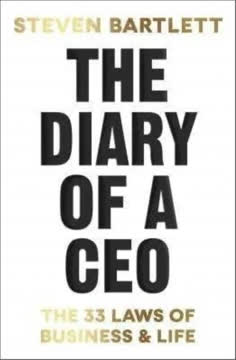Key Takeaways
1. Business Chemistry: A Framework for Understanding Work Styles
Business Chemistry is an analytics-driven tool for understanding and leveraging differences between people.
Empathy through categorization. Business Chemistry provides a practical way to identify meaningful differences in working styles, helping individuals understand and appreciate the value others bring. By offering a common language to discuss differences, it enables more effective collaboration and leadership.
Scientific foundation. The system is based on extensive research into personality traits, neurochemistry, and organizational behavior. It categorizes individuals into four main types, each with distinct characteristics and preferences in the workplace. This scientific approach provides a reliable framework for understanding and predicting behavior in professional settings.
Practical application. Business Chemistry can be applied to:
- Build healthier teams
- Enhance customer engagement
- Become more effective leaders
- Improve communication and collaboration
- Reduce conflict and misunderstandings
2. The Four Business Chemistry Types: Pioneers, Guardians, Drivers, and Integrators
Pioneers value possibilities and spark energy and imagination.
Pioneers: The Visionaries
- Outgoing, spontaneous, and adaptable
- Creative thinkers who embrace risk
- Energetic and imaginative
Guardians: The Pragmatists
- Methodical, reserved, and detail-oriented
- Value stability and bring order
- Practical and cautious decision-makers
Drivers: The Challengers
- Direct, logical, and quantitative
- Focus on results and momentum
- Competitive and willing to take calculated risks
Integrators: The Diplomats
- Diplomatic, empathic, and relationship-oriented
- Value connection and draw teams together
- Consensus-builders who see nuance
Each type brings unique strengths and potential blind spots to a team or organization. Understanding these differences can help leverage diverse perspectives for better outcomes.
3. Recognizing and Adapting to Different Types in the Workplace
To harness the power of Business Chemistry, there needs to be movement on both sides.
Developing "hunches". Learn to recognize the traits and behaviors associated with each type. Look for both unique and shared characteristics to develop an educated guess about someone's working style. Consider primary and secondary types, as well as the context and relativity of behaviors.
Flexing your style. Once you've identified someone's likely type, adapt your approach to better suit their preferences:
- For Pioneers: Embrace creativity, allow for spontaneity
- For Guardians: Provide structure and details
- For Drivers: Be direct and results-focused
- For Integrators: Emphasize relationships and consensus-building
Remember that flexing is about meeting others halfway, not completely changing who you are. The goal is to create more effective and productive interactions by understanding and accommodating different working styles.
4. The Impact of Stress and Career Aspirations on Different Types
Guardians and Integrators were the most likely to report feeling unsafe, and we saw an introversion/extroversion effect similar to the one in the stress study.
Stress responses vary by type. Research shows that Guardians and Integrators generally experience higher levels of stress and feel less psychologically safe in the workplace. This may be due to their more introverted nature and preference for stability.
Career aspirations and priorities differ:
- Pioneers and Drivers: More likely to aspire to leadership roles
- Guardians and Integrators: More likely to prioritize work-life balance and team player roles
Understanding these differences can help leaders create environments that support all types and enable them to thrive. It's crucial to recognize that what motivates one type may not be as effective for another, and to tailor approaches accordingly.
5. Leveraging Diversity for Better Decision-Making and Innovation
While decisions made in a homogeneous team feel good, they're often inferior to those made in more diverse teams.
Avoid groupthink. Teams dominated by one type are prone to cascades and groupthink, leading to suboptimal decisions. Diverse teams, while potentially more challenging to manage, often make better decisions and are more innovative.
Benefits of diversity:
- Mitigates cognitive biases
- Encourages consideration of multiple perspectives
- Enhances creativity and problem-solving
- Improves decision quality
Challenges of diversity:
- Potential for increased conflict
- Communication difficulties
- Lower initial trust and cohesion
To harness the benefits of diversity while minimizing challenges, leaders must actively manage team dynamics and create an environment where all perspectives are valued and considered.
6. Creating an Inclusive Environment for All Types to Thrive
Ultimately, an effective team leader can learn a lot from a great choir conductor.
Address essential needs. Ensure that each type's basic requirements are met:
- Guardians: Clear expectations and structure
- Pioneers: Freedom to explore ideas
- Drivers: Clear objectives and opportunities for debate
- Integrators: Time for relationship-building and consensus
Provide options and hybrid approaches. Create flexibility in work processes to accommodate different preferences:
- Make pre-work optional
- Offer multiple ways to participate in activities
- Use visual and interactive methods for detailed tasks
Foster psychological safety. Create an environment where all types feel comfortable sharing ideas and taking risks. This is particularly important for more introverted types who may be less likely to speak up in group settings.
7. Applying Business Chemistry to Leadership and Team Composition
There isn't a single right answer for how to use Business Chemistry to compose a team and foster relationships that work.
Consider context. The ideal team composition depends on various factors:
- Team goals and objectives
- Stakeholder preferences
- Current team environment
- Existing team composition
Balance strengths and weaknesses. While diversity is generally beneficial, be aware of potential challenges:
- Dominant type effects: Can lead to groupthink
- Missing type effects: May lack crucial perspectives
- Leader type influence: Can shape team culture and decisions
Actively manage diversity. To benefit from diverse perspectives:
- Encourage minority voices to speak first
- Ask team members to "think like" missing types
- Consider co-leadership with complementary types
Remember that the goal is not to change people fundamentally, but to create an environment where all types can contribute their best work.
8. Flexing Your Style for Powerful Work Relationships
Flex is a funny word, because it can mean seemingly contradictory things—to bend and stretch, but also to tighten and contract.
Adapt to opposites. When working with your opposite type, make conscious efforts to adjust your style:
- Guardians with Pioneers: Provide more high-level guidance, less structure
- Pioneers with Guardians: Offer more details and structured processes
- Drivers with Integrators: Slow down, focus on relationships
- Integrators with Drivers: Be more direct and concise
Navigate similarities. When working with the same type, be aware of potential pitfalls:
- Two Pioneers: Focus on implementation, not just ideation
- Two Drivers: Avoid power struggles, consider broader implications
- Two Integrators: Set deadlines, make decisions
- Two Guardians: Challenge the status quo when necessary
Flex in group settings. When dealing with multiple types:
- Provide options for participation
- Use hybrid approaches that meet various needs
- Be aware of your own type's influence, especially as a leader
By learning to flex your style appropriately, you can create more powerful and productive work relationships across all types.
Last updated:
FAQ
What's Business Chemistry about?
- Understanding Work Relationships: Business Chemistry by Kim Christfort explores how different personality types interact in a business setting, focusing on four primary types: Pioneers, Guardians, Drivers, and Integrators.
- Framework for Collaboration: It provides a framework for identifying these types, helping individuals understand their own working styles and those of their colleagues to enhance collaboration and productivity.
- Empathy and Chemistry: The book emphasizes the importance of empathy in crafting powerful work relationships, suggesting that understanding differences can lead to more effective teamwork.
Why should I read Business Chemistry?
- Improve Team Dynamics: Reading Business Chemistry can help you improve team dynamics by providing insights into how to engage with different personality types effectively.
- Practical Strategies: It offers practical strategies for managing, motivating, and influencing different types of people, which can be beneficial in any professional setting.
- Enhance Leadership Skills: The insights gained can enhance your leadership skills by teaching you how to create environments where all types can thrive.
What are the key takeaways of Business Chemistry?
- Four Business Chemistry Types: The book identifies four types—Pioneers, Guardians, Drivers, and Integrators—each with unique strengths and challenges.
- Flexibility is Crucial: It emphasizes the need for individuals to flex their styles to accommodate others, fostering better communication and understanding.
- Diversity Drives Performance: Leveraging the diversity of working styles can lead to improved performance and innovation within teams.
How does Business Chemistry define the four types?
- Pioneers: They value possibilities, are spontaneous, and thrive on creativity and big ideas. They often jump from topic to topic and are comfortable with risk.
- Guardians: They value stability, are detail-oriented, and prefer structured processes. They are methodical and often take their time to make decisions.
- Drivers: They value challenge, are logical and competitive, and focus on results. They make decisions quickly and are less concerned with emotional considerations.
- Integrators: They value connection, are relationship-oriented, and excel at teamwork. They are diplomatic and often seek consensus among team members.
What are the best quotes from Business Chemistry and what do they mean?
- “It’s just like dating!”: This quote highlights the importance of chemistry in business relationships, suggesting that successful interactions depend on understanding and navigating differences.
- “A spoonful of sugar helps the medicine go down.”: This emphasizes the need for leaders to present ideas in a way that is palatable to others, especially when dealing with different personality types.
- “It takes all types to make the world go round.”: This quote underscores the value of diversity in teams, suggesting that each type brings unique strengths that contribute to overall success.
How can I identify someone's Business Chemistry type?
- Look for Unique Traits: Observe behaviors that are unique to each type, such as a Pioneer’s spontaneity or a Guardian’s attention to detail.
- Consider Shared Traits: Identify traits that may be shared between types, which can help refine your understanding of someone’s working style.
- Develop a Hunch: Use the information gathered to create an educated guess about someone’s type, but remain open to adjusting your assessment based on further interactions.
What strategies does Business Chemistry suggest for engaging different work styles?
- For Pioneers: Keep discussions high-level and allow for creative exploration. Engaging Pioneers with visuals and interactive brainstorming can help maintain their interest.
- For Guardians: Provide clear agendas and detailed information in advance. Guardians appreciate structure and time to process information before making decisions.
- For Drivers: Be direct and concise, leading with key points. Drivers value efficiency and clear objectives, so minimizing fluff is essential.
- For Integrators: Encourage interpersonal connections and allow time for discussion. Integrators thrive in environments where they can gather input and build consensus.
How does stress affect different Business Chemistry types?
- Guardians Experience More Stress: Research indicates that Guardians are more likely to experience stress compared to other types, often due to their need for stability and fear of making mistakes.
- Drivers and Pioneers Handle Stress Differently: Drivers and Pioneers tend to be more resilient under stress, often viewing challenges as opportunities rather than threats.
- Coping Strategies Vary: Different types employ various coping strategies, with Guardians preferring groundwork strategies and Pioneers favoring cognitive approaches.
How do introversion and extroversion relate to Business Chemistry?
- Type Distribution: Guardians and Dreamers are generally more introverted, while Pioneers and Commanders are more extroverted, with Integrators and Drivers having mixed traits.
- Impact on Work Style: Introverts may prefer quieter environments and take longer to make decisions, while extroverts thrive in dynamic settings and are more likely to take risks.
- Cultural Influences: The societal preference for extroverted traits can impact how different types are perceived and how they navigate workplace dynamics.
What are the potential pitfalls of using Business Chemistry?
- Avoid Stereotyping: While categorizing people can be helpful, it’s important to avoid making assumptions based solely on their type, as this can lead to stereotyping.
- Recognize Individual Differences: Understand that individuals may not fit neatly into one category and can exhibit traits from multiple types.
- Be Cautious with Labels: Using labels carelessly can lead to misunderstandings and may prevent you from seeing the full range of a person's capabilities.
How can I apply the concepts from Business Chemistry in my workplace?
- Start Conversations: Use the language of Business Chemistry to discuss work styles with your colleagues. This can foster understanding and improve communication.
- Assess Team Composition: Evaluate your team's diversity in work styles and consider how to balance strengths and weaknesses. Adjust roles and responsibilities to leverage the unique contributions of each type.
- Implement Flexing Strategies: Encourage team members to flex their styles to accommodate one another. This can enhance collaboration and create a more inclusive work environment.
Review Summary
Business Chemistry receives positive reviews for providing insights into workplace personalities and relationships. Readers appreciate the four working styles (Pioneer, Guardian, Driver, Integrator) and find the framework helpful for understanding team dynamics and improving collaboration. The book is praised for its practical advice, research-based approach, and applicability to various professional settings. Some readers note its similarity to other personality assessments but find it more plausible and useful. Overall, reviewers recommend it for those seeking to enhance workplace relationships and team performance.
Similar Books










Download PDF
Download EPUB
.epub digital book format is ideal for reading ebooks on phones, tablets, and e-readers.




